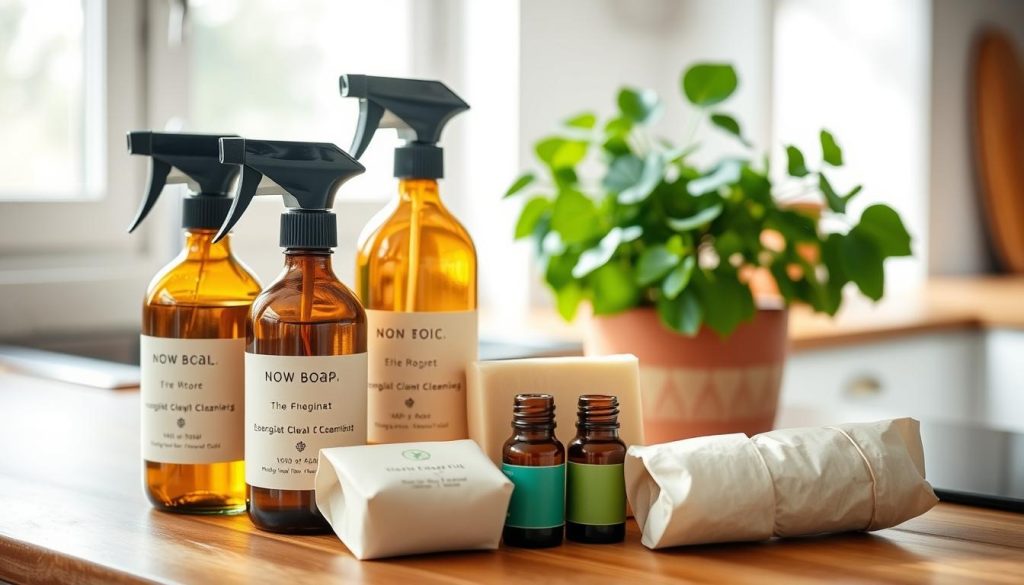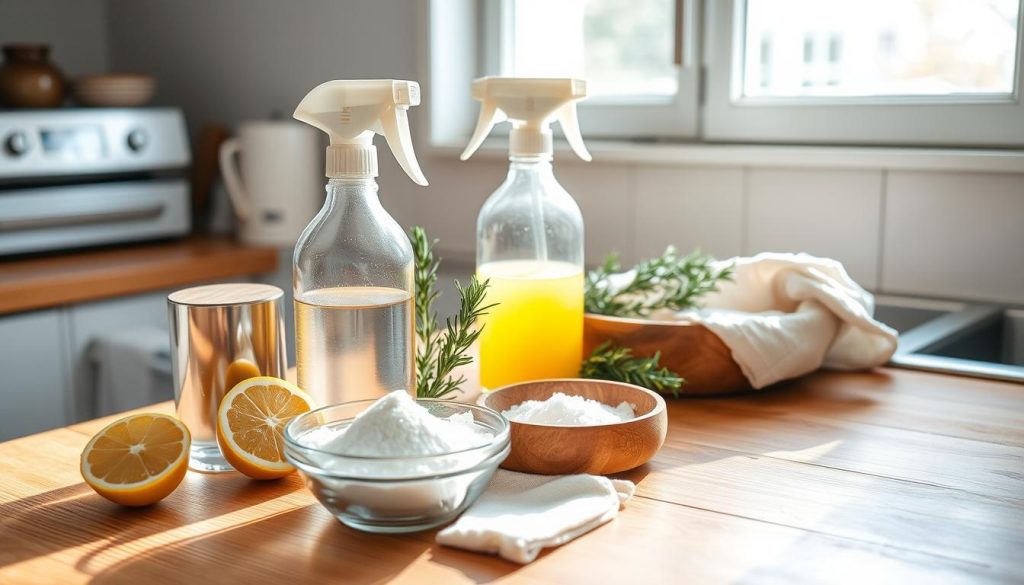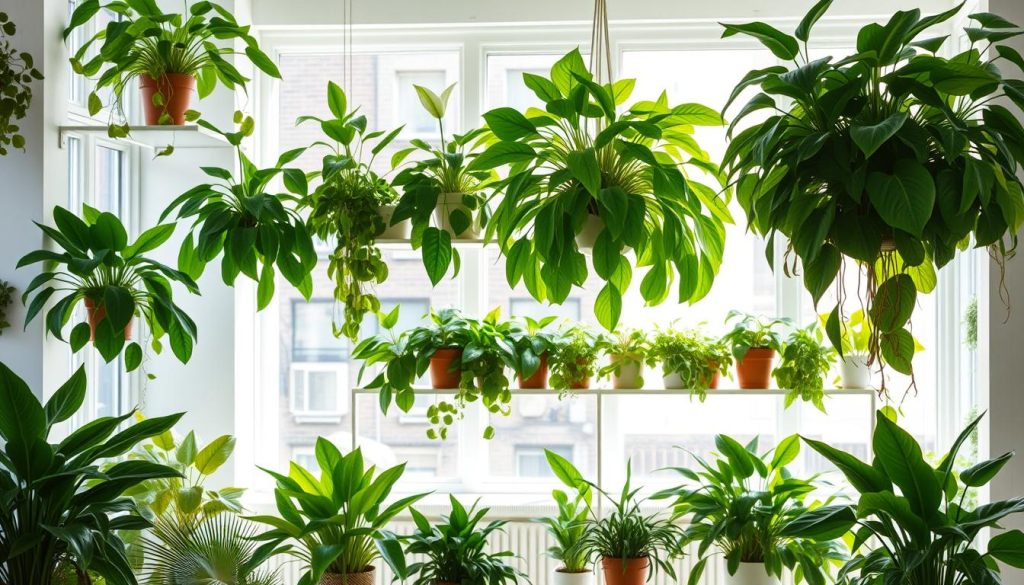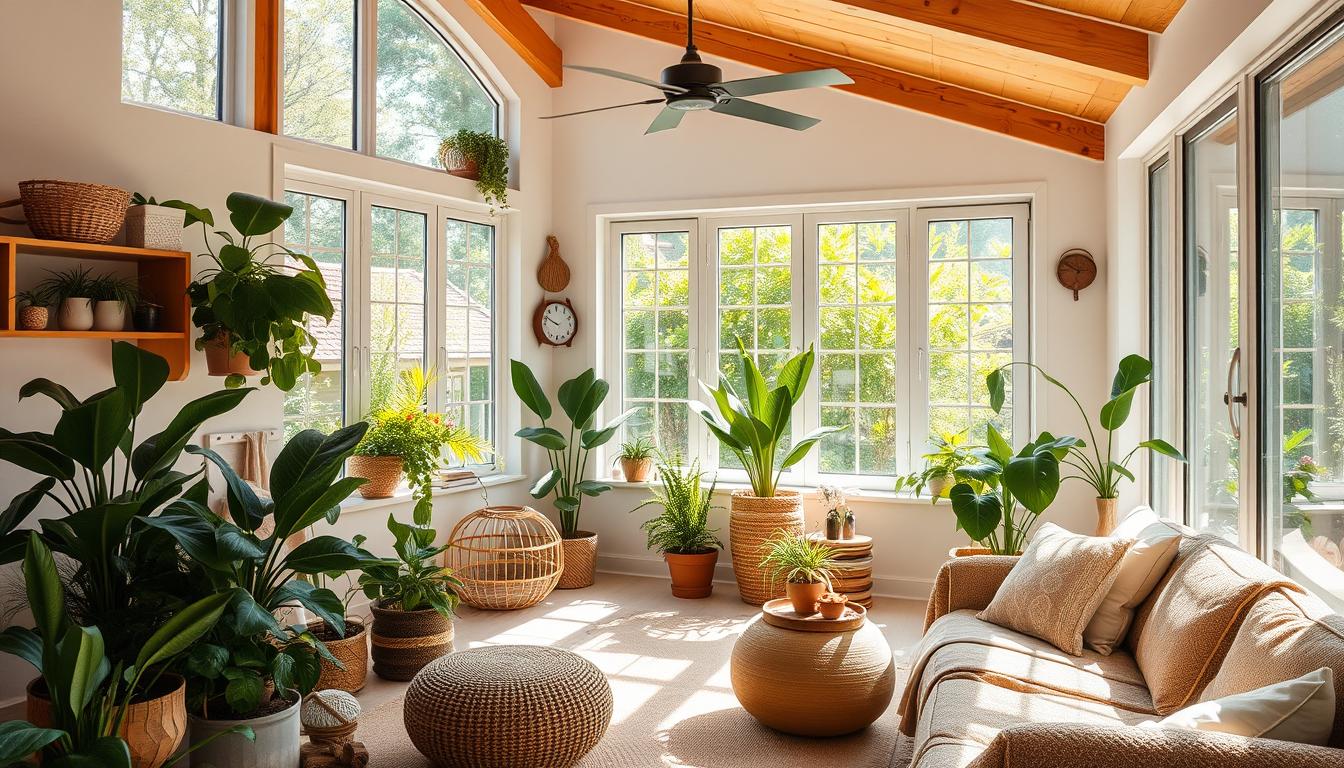Welcome to our guide on living sustainably and making your home eco-friendly. We’re all becoming more aware of our impact on the environment and our health. It’s key to know how household toxins can harm us. By using natural remedies and aiming for a toxin-free home, we can make our living spaces safer and healthier.
This guide will show you how to spot common household toxins, where they come from, and their health risks. You’ll discover simple ways to make changes, like using natural cleaners and picking non-toxic furniture. By cutting down on toxins, we improve our homes and help the planet. Let’s work together towards a healthier, toxin-free home.
Understanding Home Toxins
It’s important to know about home toxins to live healthier. These toxins are everywhere in our homes. They can harm our health.
What Are Household Toxins?
Household toxins are harmful substances found in many items at home. They include chemicals in cleaners and compounds in building materials. Each one can pose health risks.
Sources of Toxins in My Home
Many things in our homes can be toxic. Here are some common ones:
- Cleaning products with harsh chemicals.
- Building materials with toxic substances like formaldehyde.
- Furniture treated with flame retardants.
- Personal care items with synthetic fragrances.
Health Effects of Home Toxins
Being exposed to home toxins can harm our health. It can cause breathing problems, skin issues, and even cancer over time.
Research shows indoor air pollution from home toxins is worse than outdoor pollution. It’s key to understand and reduce these risks for our health.
Identifying Common Culprits

It’s important to know about harmful products in our homes. By spotting these, we can choose safer options. This means using non-toxic cleaning products and safer alternatives.
Cleaning Products
Many cleaning products have harmful chemicals like ammonia and chlorine. These can hurt our air quality and cause health issues. Choosing non-toxic cleaning products helps keep our homes healthier.
Personal Care Items
Shampoos, lotions, and cosmetics often have toxic stuff like parabens. These can irritate our skin and harm our health over time. Opt for organic or natural products to avoid these dangers.
Air Quality and Allergens
Poor air quality is a big problem, often caused by household items. Furniture and paints can release harmful gases. Using air purifiers and opening windows helps a lot.
Also, picking non-toxic cleaning products and avoiding strong scents keeps our homes clean and safe.
Practical Steps to Reduce Toxins

Reducing toxins at home is key for a healthier life. We can cut down on harmful substances by taking simple steps. This makes our homes safer for everyone.
Switching to Natural Cleaners
Using natural cleaners is a great way to reduce toxins. Many cleaning products are harmful. Seventh Generation and Method offer safer, eco-friendly options.
- Vinegar: Great for disinfecting surfaces and windows.
- Baking Soda: Perfect for scrubbing and deodorizing.
- Lemon Juice: Excellent for cutting through grease.
- Essential Oils: Add these to your cleaning solutions for a fresh scent and added antibacterial properties.
Choosing Safer Personal Care Products
Personal care items can also contain toxins. Choosing products with fewer synthetic ingredients helps. Look for natural or organic labels and avoid harmful chemicals.
- Brands to consider: Burt’s Bees, Dr. Bronner’s, and Alba Botanica.
Ventilation and Air Purifiers
Good ventilation is crucial for a toxin-free home. It helps spread out pollutants. Air purifiers also improve air quality by removing toxins and allergens.
Here are some effective air purifiers and features to look for:
| Brand | Features | Benefits |
|---|---|---|
| Honeywell | True HEPA filter, activated carbon filter | Removes up to 99.97% of airborne particles |
| Dyson | 360 Glass HEPA filter, app connectivity | Captures ultrafine particles and monitors air quality |
| Levoit | H13 True HEPA filter, ozone-free | Safe for allergies and asthma |
By following these steps, we can reduce toxins and live greener. This improves our health and well-being.
Creating a Toxin-Free Kitchen
Turning your kitchen into a safe space is key for your health and the planet. Smart choices can cut down on harmful substances. Here are some steps to make your kitchen healthier and cleaner.
Selecting Safe Food Storage
Choosing the right food storage is a simple way to make your kitchen safer. Go for glass or stainless steel over plastic. These options are tough and don’t have harmful chemicals like BPA and phthalates that can get into your food.
Avoiding Harmful Plastics
It’s important to ditch plastics. Plastic wrap, bags, and containers can release toxins, especially when heated. Instead, use beeswax wraps, silicone bags, and cloth covers. These alternatives are better for you and the planet.
Organic Choices for Better Health
Choosing organic is a big step towards a safer kitchen. Organic foods, meats, and dairy are made without harmful chemicals. This choice is better for you and helps the environment by supporting sustainable farming.
| Storage Material | Benefits | Drawbacks |
|---|---|---|
| Glass | Non-toxic, recyclable, durable | Heavy, breakable |
| Stainless Steel | Long-lasting, does not leach chemicals | Expensive, may dent |
| Plastic | Lightweight, inexpensive | Can contain harmful chemicals, not biodegradable |
| Silicone | Flexible, reusable | Can be expensive, not recyclable everywhere |
Enhancing Indoor Air Quality

Keeping the air inside your home clean is key to a healthy living space. There are many ways to do this, like making sure air flows well, adding houseplants, and keeping your HVAC systems in top shape.
Importance of Fresh Air Flow
One simple way to improve indoor air is by letting in fresh air. Open windows and doors when you can to let in clean air. This helps get rid of bad air and brings in oxygen, making your home healthier.
Houseplants that Purify Air
Adding houseplants can also make your air cleaner. Plants like spider plants, snake plants, and peace lilies can remove harmful chemicals from the air. They make your home look nice and help keep the air clean.
Regular Maintenance of HVAC Systems
It’s also important to keep your HVAC systems clean. These systems help move air around your home. But, they can get dirty over time, which can make the air worse. Regular checks and cleaning can keep your system working well and your air clean.
Here’s a quick guide to improving your indoor air quality:
| Method | Action | Benefits |
|---|---|---|
| Fresh Air Flow | Open windows and doors regularly | Reduces pollutants, improves oxygen levels |
| Houseplants | Incorporate air-purifying plants | Filters toxins, enhances aesthetics |
| HVAC Systems | Conduct regular maintenance | Removes contaminants, ensures efficient air circulation |
Reducing Toxins in the Bedroom
Creating a healthy sleeping environment is key for our well-being. We can do this by choosing non-toxic bedding, safe paint and decor, and reducing electronic devices. This helps cut down on toxins in our bedrooms and improves sleep quality.
Choosing Non-Toxic Bedding
Choosing non-toxic bedding is a simple yet effective step. Organic cotton, bamboo, and linen are good choices because they’re free from harmful chemicals. These natural fibers are not only comfy but also help reduce toxin exposure while we sleep.
Safe Paint and Decor Options
When decorating, it’s important to use low-VOC paint. VOCs, or Volatile Organic Compounds, are harmful chemicals that can release into the air. By picking low-VOC or zero-VOC paint, we create a safer space. Also, choose decor items made from natural materials that don’t release toxins.
Minimizing Electronic Devices
Electronic device pollution can also affect our sleep and health. By keeping fewer electronic devices in the bedroom, like TVs, laptops, and phones, we cut down on electromagnetic pollution. This helps us sleep better and reduces our exposure to harmful electronic pollution.
| Aspect | Action | Benefit |
|---|---|---|
| Non-Toxic Bedding | Choose organic materials | Reduces exposure to harmful chemicals |
| Low-VOC Paint | Use low or zero-VOC paint | Improves indoor air quality |
| Electronic Devices | Limit usage in the bedroom | Reduces electromagnetic pollution and promotes better sleep |
The Role of Non-Toxic Furniture
Creating a healthier home starts with choosing non-toxic furniture. Our homes should be safe spaces, free from harmful materials. These materials can harm our health.
Materials to Avoid in Furniture
When looking for new furniture, avoid materials that release harmful chemicals. Formaldehyde in pressed wood and flame retardants in upholstery are bad. They can make your home air unhealthy, causing breathing problems and other health issues.
Eco-Friendly Furniture Options
For a toxin-free home, choose eco-friendly furniture. Look for solid wood, organic cotton, and natural latex. These materials are safe and good for indoor air. West Elm, Pottery Barn, and IKEA have sustainable furniture that’s healthy for your home.
Benefits of Buying Second-Hand
Second-hand furniture markets offer unique pieces and health benefits. Used items have already released most of their harmful chemicals. This makes them safer for your home. Plus, buying second-hand helps the environment by reducing waste and the need for new resources.
| Type of Furniture | Non-Toxic Options | Benefits |
|---|---|---|
| Seating | Natural latex cushions, organic cotton covers | Reduces exposure to flame retardants and VOCs |
| Tables | Solid wood, non-toxic finishes | Eliminates formaldehyde emissions |
| Beds | Natural wood frames, organic mattresses | Promotes better sleep and reduced chemical exposure |
Choosing non-toxic and eco-friendly furniture, and buying second-hand, makes your home healthier and more sustainable. By making smart choices, we can lower our exposure to toxins and help the planet.
Committing to a Healthier Lifestyle
Starting a journey to a healthier lifestyle means making choices every day. It’s about creating a routine to remove harmful substances from our homes. Small changes can make a big difference, leading to a cleaner home and better health.
Building a Routine for Reduction
To start reducing toxins, first find where they are in your home. Switch to natural cleaning products and safer personal care items. Also, make sure to air out your home and keep your HVAC system clean. Doing these things regularly helps create a healthier lifestyle.
Engaging Family and Friends in the Process
Living healthier is more fun with the people you love. Invite your family and friends to help reduce toxins in your home. You can share tips, have clean-up days, or go to eco-friendly workshops together. This way, you build stronger bonds and a community that cares about health.
Long-term Benefits of a Toxin-Free Home
A toxin-free home brings many benefits beyond just health. It lowers the risk of serious diseases and improves your mental state. Plus, it helps the planet. Making these changes now means a better life for you and future generations. It’s a step towards lasting health and a greener world.
